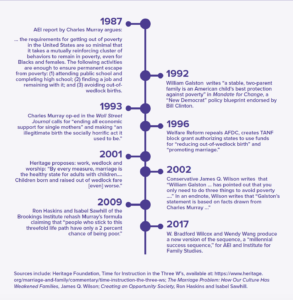The Case Against Marriage Fundamentalism: Embracing Family Justice For All
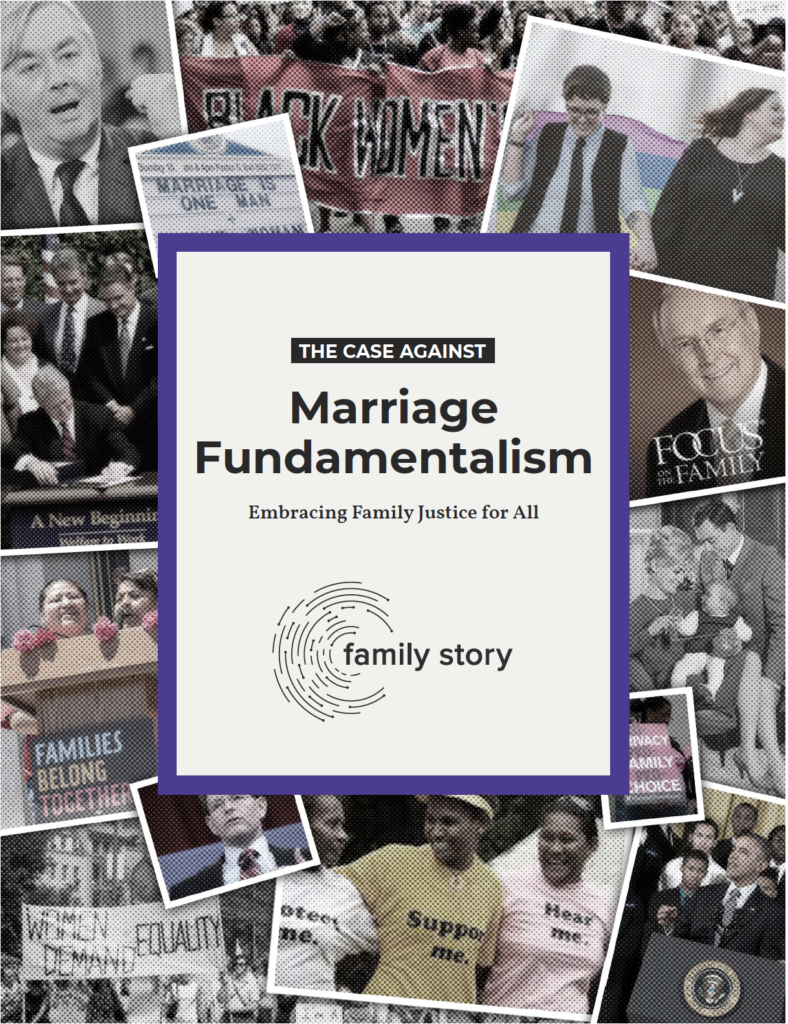
This report argues that liberals and centrists should:
- Reject Marriage Fundamentalism – Including the idea that the married two-parent family is “the best” kind of family, and that increasing marriage rates is an essential part of any agenda to reduce inequality and poverty.
- Promote Family Justice – Build a public consensus to promote family justice. Families shouldn’t be ranked from best to worst based on their structure, and marriage shouldn’t be the only option for people in close relationships of care and commitment.
What is Marriage Fundamentalism?
Marriage fundamentalism is a set of beliefs and values that view the “traditional” married family— a man and woman in their first marriage—as the most fundamental unit of society. Marriage fundamentalists believe that:
- these families are “the best” type of family, particularly for children, but also for adults and society;
- poverty and other economic risks are largely avoidable today if people stop making “bad choices,” particularly the supposed bad choice to become a parent without being married.
With funding from conservative foundations, organizations like the Heritage Foundation, Focus on the Family, and American Enterprise Institute, have promoted marriage fundamentalism as part of an ongoing culture war. As religious and cultural imperatives for marriage waned, marriage fundamentalists turned to science for proof that married, two-parent families are the best kind of family for children. Proponents of marriage fundamentalism incorrectly claim that there is scientific consensus or overwhelming evidence supporting the superiority of married, two-parent families for children.
Why Should Marriage Fundamentalism be Rejected?
- Values: It is inconsistent with core liberal, feminist and multicultural values.
- Science: An objective evaluation of the evidence does not support the contention that the two- parent family (married or not) is the superior family type for children, or that increasing the marriage rate is necessary to reduce inequality and poverty.
- Harm: Marriage fundamentalism has caused, and continues to cause, considerable political, social, and psychological harms without any offsetting benefits. Unmarried mothers, Black women and men, and LGBTQ+ people are among those most harmed.
Download Full ReportLiberals must reject the “moral preeminence of the intact two-parent family” and “affirm a plurality of family forms as valid ways of life. By virtue of its structure, no one family form is inherently better at realizing the values of family life.

The Case Against Marriage Fundamentalism traces the history of marriage fundamentalism, from the controversial 1965 Moynihan Report which characterized Black families as dysfunctional, to marriage equality, a civil rights victory for the LGBT community, but one that did not challenge the way married couples are privileged over equally valid relationships.
These four case studies demonstrate why marriage fundamentalism is harmful and should be rejected:
- The 1965 Moynihan Report
- Marriage Fundamentalists’ Favorite Formula: The Misleading “Success Sequence”
- Policy Failure: Temporary Assistance to Needy Families (TANF) and the Healthy Marriage Promotion Program
- The Dual Legacy of Marriage Equality
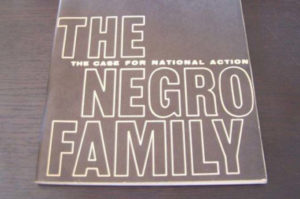 The 1965 Moynihan Report
The 1965 Moynihan Report
The 1965 Moynihan Report set the stage for the culture wars that followed in its wake. Rather than bringing right and left together around “a national effort … directed toward the question of family structure,” the divisive document is still used to justify discriminatory attitudes and harmful policies.
The “Success Sequence”
The “Success Sequence” is a repeatedly debunked and misleading formula which purports to prove that marriage is central to individual financial success and reducing poverty. We trace it back to Charles Murray, a controversial right-wing figure who has called for ending nearly all social welfare programs, and aggressive stigmatization of non-marital births.
 TANF and Healthy Marriage Promotion
TANF and Healthy Marriage Promotion
TANF and Healthy Marriage Promotion have been policy failures. 1996 “welfare reform” established marriage promotion and reduction of “out-of-wedlock” births as explicit federal policy. The federal government has spent over $1.2 billion in public funds on marriage promotion under these programs since 2006. Despite failing to increase marriage rates or reduce non-marital births, the use of federal funds for marriage promotion continues.
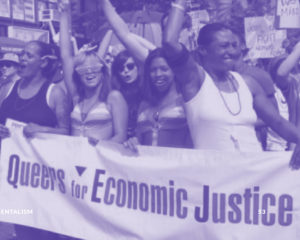
The Dual Legacy of Marriage Equality
The marriage equality movement succeeded in extending marriage rights to same-sex couples, but it did not challenge the way in which marital relationships are systematically privileged over other equally valid relationships that deserve respect and recognition.

How Have Families and Family Policy Changed Over Time?
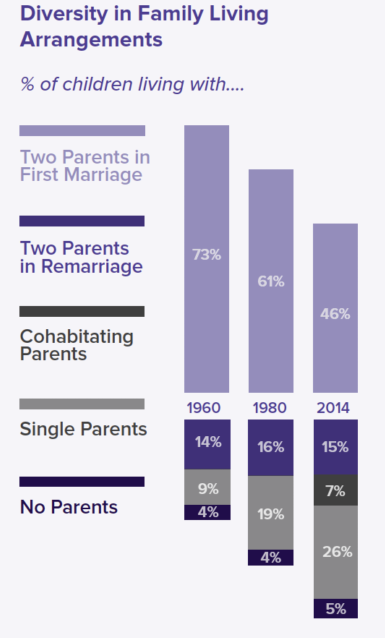 The rise of the unmarried majority: For most of U.S. history, households led by married couples have dominated demographically, with more than four out of every five households including a married couple from 1850 to 1950. In the early 1950s, the number of married- couple households began a long descent. Today, only 48 percent of households include a married couple.
The rise of the unmarried majority: For most of U.S. history, households led by married couples have dominated demographically, with more than four out of every five households including a married couple from 1850 to 1950. In the early 1950s, the number of married- couple households began a long descent. Today, only 48 percent of households include a married couple.- The public accepts the rise of the unmarried majority: Americans’ attitudes about relationships and family have become much more accepting. Roughly two-thirds of Americans today view having a child outside of marriage as morally acceptable. Agreement with this view is even higher among people under age 50.
- The reality of family disparities: Economic insecurity, inequality, and misguided policies have constrained the family-related choices of people in the diverse working-class.
- Our policies haven’t kept up: Despite the rise of the unmarried majority, and broad public acceptance of it, a long list of legal rights, benefits, and privileges available to married people remain unavailable to people who are not married. Moreover, despite the evidence that economic inequality and misguided policy have negatively shaped and constrained family-related choices and relationship health and stability, little effort has been made to fundamentally reform economic and social policies in ways that would promote family justice.
Our Laws and Policies Haven’t Kept Up
Some examples involving federal law:
- Under the federal Family and Medical Leave Act (FMLA), most employees have the right to take job-protected leave to care for a spouse, parent or child who has a serious health condition. But employees have no right under FMLA to take job- protected leave to care for their unmarried partners, close friends, or other people they think of as family.
- Social Security provides spousal and survivor benefits that are not available to unmarried partners. Various other retirement and disability programs also provide spousal benefits.
- U.S. citizens can generally bring foreign spouses to live with them in the United States as lawful permanent residents (LPRs), meaning they have the right to work and live permanently in the United States, and can obtain U.S. citizenship within a few years. U.S. citizens cannot bring unmarried partners to live with them as LPRs, unless their partner is eligible for an immigration visa under some other, generally more restrictive, pathway (such as being a refugee or qualifying for an employment-based immigration visa).
Our laws and policies haven’t kept up with the rise of the unmarried majority. Systemic reforms are needed to ensure that our laws recognize and support the full range of close personal relationships that are central to life today.
Download Full Report

The Case Against Marriage Fundamentalism: Embracing Family Justice for All advocates for liberals and centrists to reach a new consensus to promote family justice. This consensus would:
- respect the equal value and legitimacy of different kinds of family arrangements, including: married and unmarried couples; co-parenting arrangements, whether divorced, separated, or never together; adults “living apart together,” kin networks, and chosen family;
- reject the idea that these kinds of families and relationships can or should be ranked from best to worst;
- view family, care, and community as central and enduring parts of most people’s lives, and critical to children’s well-being and success.
While a family-justice consensus would reject marriage fundamentalism, it is not against marriage. Rather, it sees marriage as only one of many valid paths. For many married people, the fact of being married carries significant personal, cultural, and religious meaning, many unmarried adults aspire to marriage for the same reasons.
An Agenda for Family Justice
A comprehensive and robust agenda for family justice needs to include both policy and cultural change. As a starting point, this report makes the following policy recommendations:
- Remove marriage promotion and “out-of-wedlock”-birth reduction as purposes of the TANF program, and repeal the Healthy Marriage Promotion program;
- Provide additional legal options for relationships, like civil unions and registered partnerships;
- Provide information easily accessible to the public about the legal rights and responsibilities of marriage and any other legal options for relationships;
- Review federal, state, and local laws that condition benefits and rights on marriage, and, where appropriate, provide such benefits and rights in a more inclusive manner. Examples include: ensuring that work-family benefits like job-protected leave and paid sick days include non-marital partners and other “chosen family,” and treating domestic partnerships the same as marriage for purposes of federal immigration law;
- Reform the Child Tax Credit to make this child allowance available to all low-income parents;
- Reform crime, immigration, and child welfare laws to minimize forced family separation and harm to children.
Download Full Report

Trump’s Attacks on Families
Conservative politicians and the religious right routinely extol the importance of families, but unfortunately, not all families are seen or treated as equally important. Policies promoted by the Trump Administration reinforce this worldview about families, as well as the racist and sexist ideas that undergird its foundation. To address these timely issues, Family Story has produced “Trump’s Attacks on Families” as a short companion piece to our report, The Case Against Marriage Fundamentalism: Embracing Justice for All.
